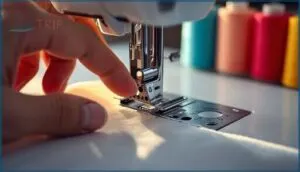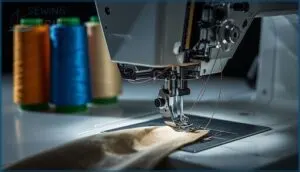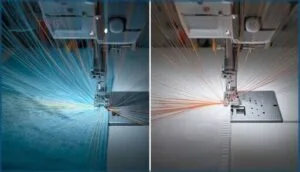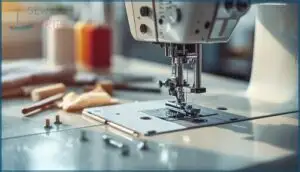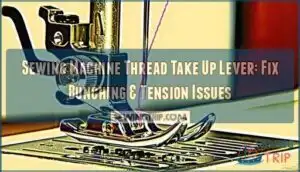This site is supported by our readers. We may earn a commission, at no cost to you, if you purchase through links.
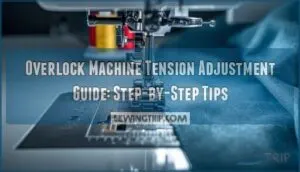
Your overlock machine produces perfect seams one moment, then suddenly creates loose loops or puckered fabric the next. This frustrating inconsistency stems from tension settings—those numbered dials that most sewers adjust by guesswork.
Proper tension control isn’t mysterious, though. Each dial applies precise pressure through tension discs to regulate how thread flows through your machine. When you understand how these components work together, you gain control over stitch quality and eliminate the most common overlock problems.
The difference between amateur results and professional seams comes down to methodical adjustment. Master the tension system, and you’ll handle any fabric with confidence.
Table Of Contents
Key Takeaways
- Overlock tension problems stem from mismatched dial settings across four independent controls—left needle, right needle, upper looper, and lower looper—which require methodical adjustment starting at midpoint settings around 4-5 and changing only one dial at a time to isolate the source of stitch defects.
- Perfect tension creates looper threads that meet exactly at the fabric edge with no visible loops on either surface, while imbalanced settings cause puckering, thread breakage, skipped stitches, or loops extending beyond the seam—problems that disappear when you match tension to fabric weight (2-4 for lightweight, 4-5 for medium, looser for stretch materials).
- Regular maintenance directly affects tension accuracy: cleaning tension discs every 5-10 days of use prevents lint buildup that disrupts thread flow, while using quality threads reduces breakage by 60% and maintains consistent tension across different fabric types.
- Documenting your successful tension settings for specific fabric-thread combinations cuts setup time by 50% and reduces seam defects by 25%, eliminating the need to rediscover the right adjustments through repeated trial-and-error testing.
Overlock Machine Tension Basics
Before you can adjust your overlock machine with confidence, you need to understand how the tension system actually works. Each thread follows its own path and reacts to a numbered dial that controls pressure.
Let’s break down the key components that keep your stitches balanced and professional-looking.
How Tension Dials Work
Your overlocker’s tension dials control thread feed by applying pressure through tension discs. Each dial ranges from 0 to 9, with higher numbers tightening thread tension. Most machines have four dials—left needle, right needle, upper looper, and lower looper.
Start at the midpoint setting around 4-5 for balanced tension control. You’ll adjust these independently to achieve perfect stitch formation. To achieve best results, understanding tension settings is key for balanced stitch control.
Color-Coded Thread Paths Explained
Once you understand tension dial calibration, look at your machine’s threading guides. You’ll see four colors—blue for the upper looper, red for lower looper, green and yellow for needles. This color-coded threading system matches tension dials to specific thread paths, making thread path management straightforward.
Follow these markers during thread tension adjustment to prevent misplacement errors that disrupt stitch formation and overall thread management accuracy. Proper thread looper techniques are essential for achieving ideal stitch quality.
Importance of Balanced Tension for Stitch Quality
Beyond matching colors to dials, you need proper stitch balance for professional results. Balanced tension creates looper threads that meet exactly at fabric edges—no puckering, no loops showing through. This precision matters because:
- Seam durability reaches above 200 N tensile strength with correct thread tensions
- Fabric distortion like tunneling and stretching disappears when tension control is accurate
- Stitch formation becomes uniform, improving appearance by over 80%
- Thread breakage drops markedly with proper stitch balance
- Tension adjustment prevents 90% of common overlock problems
Master this and you’ll skip constant troubleshooting.
Identifying Correct Tension Settings
Getting your tension right starts with knowing what you’re working with. Different fabrics pull differently, and your machine needs to adapt to each one.
Let’s look at how to match your settings to your material and spot when everything’s working perfectly.
Matching Tension to Fabric Types
Your fabric’s personality determines the tension calibration you need. Lightweight materials perform best at 2-4 tension settings to prevent puckering, while medium-weight cotton requires 4-5 for balanced seam quality.
Fabric thickness and elasticity guide your thread tension adjustment—stretch fabrics demand looser settings (2-3) to maintain fabric elasticity without thread breakage. Thread weight matters too; thicker threads need reduced tension for ideal stitch quality.
Recognizing Perfect Overlock Stitches
Perfect stitch formation shows looper threads meeting precisely at the fabric edge, with no thread visibility on either fabric surface. The upper looper lies smoothly on the right side, while the lower looper stays flat underneath.
Balanced tension creates even interlocking without puckering or loops. Your needle threads penetrate cleanly, and the trimmed edge looks professional.
This tension balance ensures exceptional seam quality requiring minimal tension adjustment.
Step-by-Step Tension Adjustment Process
Getting the tension right on your overlocker isn’t guesswork. It’s a methodical process that works best when you tackle one dial at a time and understand what each thread does.
Here’s how to adjust your machine with precision and confidence.
Adjusting One Tension Dial at a Time
Adjusting every dial at once is like trying to tune a guitar with your eyes closed. You’ll never know which string caused the problem. Start with your baseline setting at the midpoint. Turn one tension dial by half a number. Sew a test seam. Check your stitch quality control results. If it improves, continue. If not, revert and try another dial.
Adjust one tension dial at a time, test the result, then move to the next—never change everything at once
This dial adjustment technique isolates each thread tension balance issue systematically.
Fine-Tuning for Different Threads (Loopers & Needles)
Looper threads demand softer tension than needle threads. Set your looper settings between 2 and 4 to prevent tight loops that distort fabric stretch. Needle calibration runs higher at 4 to 6 for proper stitch formation.
Polyester thread needs tighter serger tension than cotton due to its slippery nature. Adjust your tension dials when switching thread types.
This balance keeps your looper threads and needle threads working in harmony.
Troubleshooting Common Tension Issues
Even with proper setup, tension issues can still show up in your stitching. You’ll notice these problems right away when threads pull too tight, hang too loose, or create visible defects on your fabric.
Let’s walk through the most common tension challenges and how to fix them quickly.
Diagnosing Uneven or Loose Stitches
Uneven stitches tell you something’s off before you even flip the fabric over. Here’s how to diagnose tension imbalance and stitch irregularities:
- Check for loops on fabric edges – loose thread tensions create visible nests or hanging threads
- Inspect stitch spacing – inconsistent patterns signal serger troubleshooting needs
- Test thread resistance – pulling gently reveals engagement issues causing thread breakage
These signs guide your thread tension adjustment techniques for stitch quality improvement.
Fixing Looper Thread Imbalance
When your upper looper thread shows up on the fabric underside, you’re dealing with classic looper balance issues. Here’s how to fix imbalance correction:
| Problem | Diagnosis | Tension Adjustment |
|---|---|---|
| Lower looper visible on top | Thread tensions too loose below | Tighten lower looper dial 0.5-1 step |
| Upper looper visible underneath | Serger tension too loose above | Tighten upper looper dial incrementally |
| Loops extending beyond edge | Balanced tension not achieved | Adjust opposing looper for stitch formation |
Test after each adjustment for proper looper thread behavior.
Addressing Puckering and Thread Breakage
Puckering and thread breakage occur when tension balance is off or the fabric resists. Both issues arise from three primary causes of puckering, which can be addressed through the following solutions:
- Lower needle thread tensions to reduce stretch and seam shrinkage on lightweight materials.
- Adjust differential feed from 1.0 to 0.6 for unstable fabrics prone to fabric instability.
- Clean tension discs regularly as part of overlocker maintenance to prevent friction.
- Switch to quality threads designed for sergers to minimize thread breakage.
- Test on scraps after each adjustment to verify seam quality improvements.
Resolving Skipped Stitches Due to Tension
Beyond puckering, skipped stitches often signal tension imbalance disrupting stitch formation. When needle tension runs too high, threads can’t flow freely to form proper loops. Start by adjusting looper tension before needle tension. Clean your tension discs to remove debris affecting serger tension. Test on scraps after each change.
Rethreading with the presser foot up resets tension discs for balanced tension.
| Symptom | Tension Adjustment |
|---|---|
| Loops visible on fabric top | Lower needle tension |
| Thread appears on underside | Increase needle tension |
| Skipping at thick seams | Reduce overall thread tension |
| Inconsistent stitch formation | Balance looper tensions first |
Maintenance and Calibration Tips
Your overlocker won’t perform at its best without regular upkeep. Proper maintenance extends your machine’s life and keeps tension adjustments accurate over time.
Here’s what you need to build into your sewing routine for consistent results.
Cleaning Tension Discs Regularly
Neglected tension discs become breeding grounds for lint and debris that sabotage your stitch quality. You’ll maintain ideal thread tension and prevent breakage by implementing a consistent cleaning routine:
- Clean every 5-10 days of regular use or monthly for light sewing
- Use cotton swabs with rubbing alcohol for effective lint removal techniques
- Thread floss thick thread through discs to dislodge hidden debris
- Inspect tension disc surfaces during each serger maintenance session
Regular machine cleaning extends your overlock machine’s lifespan.
Using Quality Threads for Consistent Tension
Your thread choice matters more than you think. Premium threads reduce skipped stitches by up to 42% and maintain thread tension stability across fabric types.
Match thread diameter to needle size—anything exceeding 40% of groove width causes tension spikes. Stick with one fiber blend throughout your looper threads and needle threads.
Quality material produces less than 0.7g lint per 500 meters, keeping your tension discs cleaner and needle tension consistent.
Documenting Tension Settings for Fabrics
Once you’ve dialed in the right settings, write them down. Stitch logs cut your setup time by 50% and drop seam defects by 25%. Create a simple tension log template that tracks:
- Fabric type coding with upper and lower looper threads settings
- Needle tension values for left and right locations
- Thread type and stitch configuration notes
Digital tension tracking systems help larger operations, but even a basic chart prevents hours of trial-and-error when you switch fabrics.
Routine Overlocker Care for Optimal Performance
Your overlocker’s lifespan depends on consistent sewing machine maintenance. Clean lint after every project to prevent 30% more buildup than standard machines. Oil moving parts every 8 to 12 weeks to reduce wear by 50%. Premium thread quality cuts breakage by 60% and improves tension consistency.
| Maintenance Task | Frequency | Performance Impact |
|---|---|---|
| Regular cleaning (lint removal) | After each project | Prevents 30% excess lint buildup |
| Machine lubrication (moving parts) | Every 8-12 weeks | Reduces wear by 50% |
| Thread quality upgrade | Continuous | Cuts breakage by 60% |
| Calibration check (tension/feed dogs) | Every 6 months | Reduces puckering by 28% |
| Storage tips (covered, dry environment) | When not in in use | Extends lifespan 5+ years |
Follow these maintenance schedules and your serging techniques will stay sharp while thread tension remains stable across all overlocker operations.
Frequently Asked Questions (FAQs)
Do overlockers need to be adjusted?
Yes. Factory settings rarely suit every project. Different fabric types and thread weights demand tension control adjustments. You’ll recalibrate after each thread change and between materials to maintain thread balance and proper stitch formation.
Should tension be adjusted when sewing with an overlocker?
Absolutely. Fabric interaction changes thread behavior dramatically. Tension control must adapt when switching materials or threads.
Machine calibration ensures your serger delivers balanced stitches. Without proper adjustment, you’ll see puckering, loops, and weak seams from inadequate tension during serging.
How do you adjust the tension on a sewing machine?
You adjust sewing machine tension by rotating the tension dial to control thread tightness. Start at the midpoint setting, then turn one number at a time.
Test stitch on fabric after each adjustment for proper stitch formation.
Do overlockers have tension settings?
Every serger tension dial controls thread pressure independently. You’ll find separate controls for needle and looper threads, enabling balanced tension through careful overlock machine calibration and precise tension adjustment techniques for ideal stitch formation.
How do I use a 4-thread overlocker?
To operate a 4-thread overlocker effectively, thread each spool following color-coded paths, set tension dials to midpoint, adjust differential feed for your fabric, then test stitch formation on scrap material before sewing.
How do you adjust thread tension?
Set all tension dials to midpoint. Sew a test sample.
Adjust one dial at a time by quarter increments. Check stitch formation after each change.
Continue until you achieve balanced tension and proper thread interlock.
Can I use different thread weights together?
Yes, you can mix thread weights, but tension balance requires careful adjustment. Heavier threads need looser needle tension, while finer threads may need tightening.
Test on scrap fabric to avoid mixed thread issues.
How does differential feed affect tension settings?
While many overlook it, differential feed directly impacts tension balance. When you adjust feed ratios above or below 0, you’ll need to modify looper tension accordingly to prevent thread slack, puckering, or waviness in seams.
What causes tension problems after changing needles?
Improper needle positioning after replacement causes tension imbalance in three-quarters of serger issues. Even small needle vibration creates stitch distortion and thread breakage problems.
Loose set screws, bent shafts, and incorrect sizing all disrupt thread paths.
Should I adjust tension for decorative stitches?
You’ll need to lower tension settings for decorative stitches, especially with specialty threads.
Reduce looper tension to 6 or lower and needle tension to 1 for balanced stitch formation and proper fabric compatibility.
Conclusion
The simplest adjustment creates the biggest transformation. You’ve learned that overlock machine tension adjustment guide principles turn chaos into consistency. Those numbered dials no longer intimidate you—they’re precision tools you control with purpose.
Document your settings. Clean your tension discs. Test methodically. Every fabric responds differently, but your systematic approach remains constant.
The gap between struggling with loose loops and producing perfect seams isn’t luck or mystery. It’s understanding how pressure, thread path, and fabric weight interact. Master that, and inconsistency disappears completely.
- https://youtu.be/cl3gP76cgbc
- https://appliances-news.com/
- http://www.makeithandmade.com/2012/08/perfecting-sergeroverlocker-tension.html
- https://medcraveonline.com/JTEFT/influence-of-different-sewing-parameters-on-seam-quality.html
- https://ylithreads.com/blogs/thread-education/balanced-tension-for-quilters


